Cadillac
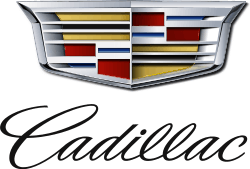 | |
| Division | |
| Industry | Automotive |
| Predecessor | Henry Ford Company |
| Founded | August 22, 1902 in Detroit, Michigan, U.S. |
| Founder |
|
| Headquarters | New York City, New York, United States |
Area served | United States, Canada, Mexico, Europe, Middle East (excl. Iran and Syria), China, South Korea, Japan |
Key people | Steve Carlisle, President, Cadillac |
| Products | Luxury vehicles |
| Owner | General Motors |
| Website |
www |
|
Footnotes / references [1] | |
Cadillac /ˈkædɪlæk/, formally the Cadillac Motor Car Division, is a division of the U.S.-based General Motors (GM) that markets luxury vehicles worldwide. Its primary markets are the United States, Canada, and China, but Cadillac-branded vehicles are distributed in 34 additional markets worldwide. Historically, Cadillac automobiles have always held a place at the top of the luxury field within the United States.[2] In 2017, Cadillac's U.S. sales were 156,440 vehicles and its global sales were 356,467 vehicles.[3]
Cadillac is among the oldest automobile brands in the world, second in the United States only to fellow GM marque Buick. The firm was founded from the remnants of the Henry Ford Company in 1902.[4] It was named after Antoine de la Mothe Cadillac, who founded Detroit, Michigan. The Cadillac crest is based on his coat of arms.
By the time General Motors purchased the company in 1909, Cadillac had already established itself as one of America's premier luxury carmakers. The complete interchangeability of its precision parts had allowed it to lay the foundation for the modern mass production of automobiles. It was at the forefront of technological advances, introducing full electrical systems, the clashless manual transmission and the steel roof. The brand developed three engines, with its V8 setting the standard for the American automotive industry.
Cadillac was the first American car to win the Royal Automobile Club of the United Kingdom's Dewar Trophy by successfully demonstrating the interchangeability of its component parts during a reliability test in 1908; this spawned the firm's slogan "Standard of the World". It won the trophy again in 1912 for incorporating electric starting and lighting in a production automobile.[5]
Early history
Founding
Cadillac was formed from the remnants of the Henry Ford Company. After a dispute between Henry Ford and his investors, Ford left the company along with several of his key partners in March 1902. Ford's financial backers William Murphy and Lemuel Bowen called in engineer Henry M. Leland of Leland & Faulconer Manufacturing Company to appraise the plant and equipment in preparation for liquidating the company's assets. Instead, Leland persuaded the pair to continue manufacturing automobiles using Leland's proven single-cylinder engine. A new company called the Cadillac Automobile Company was established on 22 August 1902, re-purposing the Henry Ford Company factory at Cass Street and Amsterdam Avenue. It was named after French explorer Antoine Laumet de La Mothe, sieur de Cadillac, who had founded Detroit in 1701.[6][7]
First automobiles
Cadillac's first automobiles, the Runabout and Tonneau, were completed in October 1902. They were two-seat horseless carriages powered by a 10 hp (7 kW) single-cylinder engine. They were practically identical to the 1903 Ford Model A. Many sources state that the first car rolled out of the factory on 17 October; in the book Henry Leland – Master of Precision, the date is 20 October; another reliable source shows car number three to have been built on 16 October. Cadillac displayed the new vehicles at the New York Auto Show in January 1903, where the vehicles impressed the crowds enough to gather over 2,000 firm orders. Cadillac's biggest selling point was precision manufacturing, and therefore, reliability; a Cadillac was simply a better-made vehicle than its competitors.
- Runabout
.jpg) 1902
1902 6½ HP 1904
6½ HP 1904_at_Autoworld_Brussels_(8394291773).jpg) 1907
1907.jpg) 1907
1907.jpg) 1908 with dickey seat open
1908 with dickey seat open
- Rear-entrance tonneau
 1903
1903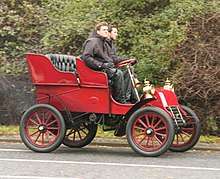 6½ HP 1903
6½ HP 1903 8¼ HP 1904
8¼ HP 1904 8¼ HP surrey-top 1904
8¼ HP surrey-top 1904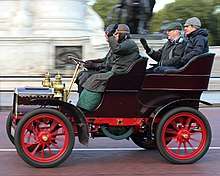 10 HP 1904
10 HP 1904
- Special bodies
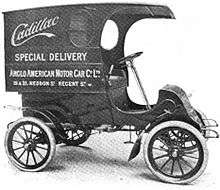 Delivery 1903
Delivery 1903 8½ HP touring car 1904
8½ HP touring car 1904 8¼ HP Detachable-top limousine 1904
8¼ HP Detachable-top limousine 1904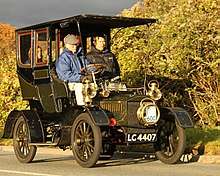 9 HP limousine
9 HP limousine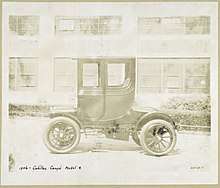 Model M Coupé 1907
Model M Coupé 1907
Notable events: 1906–1912
The Cadillac Automobile Company merged with Leland & Faulconer Manufacturing, forming The Cadillac Motor Company in 1905.[8]
From its earliest years, Cadillac aimed for precision engineering and stylish luxury finishes, causing its cars to be ranked amongst the finest in the United States.
Cadillac was the first volume manufacturer of a fully enclosed car, in 1906. Cadillac participated in the 1908 interchangeability test in the United Kingdom, and was awarded the Dewar Trophy for the most important advancement of the year in the automobile industry. In 1912, Cadillac was the first automobile manufacturer to incorporate an electrical system enabling starting, ignition, and lighting.[9][10]
Acquired by General Motors: 1909
Cadillac was purchased by the General Motors (GM) conglomerate in 1909.[11] Cadillac became General Motors' prestige division, devoted to the production of large luxury vehicles. The Cadillac line was also GM's default marque for "commercial chassis" institutional vehicles, such as limousines, ambulances, hearses and funeral home flower cars, the last three of which were custom-built by aftermarket manufacturers.
It became positioned at the top of GM's vehicle hierarchy, above Buick, Oldsmobile, Oakland, and later, Chevrolet.
The Origins of Cadillac Becoming the "Standard of the World": 1915–1941
In 1915, Cadillac introduced a 90-degree flathead V8 engine with 70 horsepower (52 kW) at 2400 rpm and 180 pound force-feet (240 N⋅m) of torque, allowing its cars to attain 65 miles per hour (105 km/h).[10] This was faster than most roads could accommodate at this time. Cadillac pioneered the dual-plane V8 crankshaft in 1918. In 1928 Cadillac introduced the first clashless Synchro-Mesh manual transmission, utilizing constant mesh gears. In 1930 Cadillac implemented the first V-16 engine, with a 45-degree overhead valve, 452 cubic inches (7.41 litres), and 165 horsepower (123 kW), one of the most powerful and quietest engines in the United States. The development and introduction of the V8, V16 and V-12 helped to make Cadillac the "Standard of the World".[10] A later model of the V8 engine, with overhead valves, set the standard for the entire American automotive industry in 1949.[10]
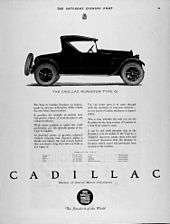
In July 1917, the United States Army needed a dependable staff car and chose the Cadillac Type 55 Touring Model after exhaustive tests on the Mexican border. 2,350 of the cars were supplied for use in France by officers of the American Expeditionary Force in World War I.[12]
General Motors of Canada had built Cadillacs from 1923 until 1936 and LaSalles from 1927 until 1935.[13]
Pre-World War II Cadillacs were well-built, powerful, mass-produced luxury cars aimed at an upper-class market. In the 1930s, Cadillac added cars with V12 and V16 engines to their range, many of which were fitted with custom coach-built bodies.[14]
In 1926, Cadillac recruited automobile stylist Harley Earl in a one-time consulting capacity, but his employment lasted considerably longer: by 1928, Earl was the head of the new Art and Color division and he would ultimately work for GM until he retired, over 30 years later. The first car he designed was the LaSalle, a new, smaller "companion marque" car, named after another French explorer and founder of Detroit, René Robert Cavelier, Sieur de La Salle. That marque remained in production until 1940.[15]
Cadillac introduced designer-styled bodywork (as opposed to auto-engineered) in 1927. It installed shatter-resistant glass in 1926. Cadillac also introduced the "turret top", the first all-steel roof on a passenger car.[10] Previously, car roofs had been made out of fabric-covered wood.
The Great Depression sapped the auto industry generally, with the luxury market declining more steeply; between 1928 and 1933, Cadillac sales declined by 84% to 6,736 vehicles.[16] Exacerbating sales performance for the Cadillac brand was a policy, reflective of the times, which discouraged sales to African Americans.[17] Nick Dreystadt, mechanic and national head of Cadillac service, urged a committee – set up to decide whether the Cadillac brand would live on – to revoke that policy. After the policy was eliminated, brand sales increased by 70% in 1934 – and Dreystadt was promoted to lead the entire Cadillac Division.[17]
By 1940, Cadillac sales had risen tenfold compared to 1934.[14] In 1936, Dreystadt released the Series 60 as Cadillac's entry into the mid-priced vehicle market. It was replaced by the Series 61 in 1939, but a popular model that was derived from it, the Sixty Special, continued through 1993. Another factor helped boost Cadillac growth over the next few years: a revolution in assembly line technology. In 1934, Henry F. Phillips introduced the Phillips screw and screwdriver to the market. He entered into talks with General Motors and convinced the Cadillac group that his new screws would speed assembly times and therefore increase profits. Cadillac was the first automaker to use the Phillips technology, in 1937, which was widely adopted in 1940.[18] For the first time in many years all cars built by the company shared the same basic engine and drivetrain in 1941.[19]
1941 also saw introduction of optional Hydra-Matic, the first mass-produced fully automatic transmission, offered the previous year on the Oldsmobile.
 1910 Cadillac Model S
1910 Cadillac Model S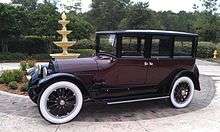 1921 Cadillac Suburban
1921 Cadillac Suburban 1929 Cadillac
1929 Cadillac 1929 Cadillac Fleetwood
1929 Cadillac Fleetwood- 1931 Cadillac Phaeton
 1932 Cadillac 355B V8 Sedan
1932 Cadillac 355B V8 Sedan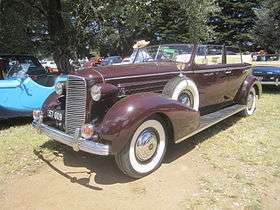 1936 Cadillac Series 70 4 door Convertible V8
1936 Cadillac Series 70 4 door Convertible V8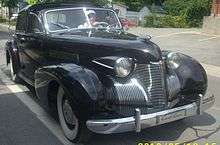 1939 Cadillac Series 75 town car
1939 Cadillac Series 75 town car- 1940 Cadillac 90 Town Car
After World War II & The Great Depression: 1945–1959

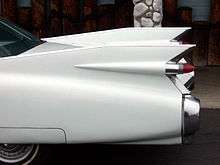
Postwar Cadillac vehicles innovated many of the styling features that came to be synonymous with the late 1940s and 1950s American automobile. Incorporating many of the ideas of then General Motors styling chief Harley J. Earl, these included tailfins, wraparound windshields, and extensive use of chrome.
Tailfins were first added in 1948[10] and reached their pinnacle in 1959. From 1960 to 1964 they decreased each year until they disappeared in the 1965 model year (remaining vestigialy only on the limited production 1965 Series 75 chassis, a carry-over from 1964).
Cadillac's other distinctive styling attribute was its front-bumper. What had started out after the war as a pair of artillery shell-shaped bumper guards[20] moved higher on the front-end design as the 1950s wore on. Becoming known as Dagmar bumpers for their similarity to the buxom 1950s television personality, they were toned down in 1958 and gone the next year. 1956 saw the introduction of the pillarless four-door hardtop sedan, marketed as the "Sedan de Ville"; a year later the feature appeared in all standard Cadillacs. The fledgling automotive magazine Motor Trend awarded its first "Motor Trend Car of the Year" to Cadillac in 1949 for its innovative overhead valve V8 engine. While the company initially snubbed the honor, it now proudly references its "Car of the Year" wins in publicity material.[21][22] On November 25, 1949, Cadillac produced its one-millionth car, a 1950 Coupe de Ville.[23] It also set a new sales mark of 100,000 cars,[23] matched in 1950 and 1951.[24] 1949 also saw the introduction with Buick of the first mass-produced hardtop coupe, a closed-body style without a "B" pillar. Marketed as the Coupe de Ville, it would become one of Cadillac's most popular models for many years.
In 1951, Cadillac began production of the M41 Walker Bulldog army tank, which saw service in the Korean and Vietnam wars.
In 1953, the "Autronic Eye" was introduced. This feature would automatically dim high-beam headlamps for the safety of oncoming motorists.[25] In 1957, Cadillac attempted to move further upmarket, creating the hand-built Series 70 Eldorado Brougham.[26] It featured self-levelling suspension, "memory seat" function, and an all-transistor signal-seeking car radio that was produced by GM's Delco Radio and which was available as standard equipment for the 1957 Eldorado Brougham models.[20][27][28][29] While the car showed Cadillac's technological prowess, it only sold 904 units.
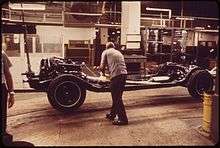
New Pinnacles in Luxury & Dimension: 1960–1976
The dual-reservoir brake master cylinder, with separate front and rear hydraulic systems, was introduced in 1962, six years ahead of the Federal requirement. The first fully automatic heater-air conditioning system also appeared, as did the three-speed Turbo-Hydramatic automatic transmission; it would become the GM standard model for several decades. From the late 1960s, Cadillac offered a fiber-optic warning system to alert the driver to failed light bulbs. The use of extensive bright-work on the exterior and interior also decreased each year after 1959. By the 1966 model year, even the rear bumpers ceased to be all chrome – large portions were painted, including the headlight bezels.
In 1966, Cadillac had its best annual sales yet, over 192,000 units (142,190 of them de Villes),[30] an increase of more than 60%.[31] This was exceeded in 1968, when Cadillac topped 200,000 units for the first time.[32] 1967 and 1968 saw the introduction of a host of federally mandated safety features, including energy-absorbing steering columns and wheels, soft interior and instrument panel knobs and surfaces, front shoulder belts, and side marker lights.
The front-wheel-drive Eldorado was launched in 1967, setting a new standard for a personal luxury car. Its simple, elegant design was a far cry from the tailfin and chrome excesses of the 1950s. Cadillac's success grew against rivals Lincoln and Imperial, which had division sales topping all of Chrysler for the first time in 1970.[33] The new 472 cu in (7.7 l) engine that debuted in the 1968 model year, designed for an ultimate capacity potential of 600 cu in (9.8 l),[34] was increased to 500 cu in (8.2 l) for the 1970 Eldorado. It was adopted across the model range beginning in 1975. Driver and front passenger airbags ("Air Cushion Restraint System") began to be offered on some Cadillac, as well as other Buick and Oldsmobile luxury models, in 1974, however this option was unpopular as was discontinued after the 1976 model year. The pillarless Coupe deVille ended with the 1973 model, while the Sedan deVille remained pillarless through 1976.
The 1970s saw new extremes in vehicle luxury and dimension. The 1972 Fleetwood was some 1.7 in (43 mm) longer in wheelbase and 4 in (100 mm) overall, compared to the 1960 Series 75 Fleetwood; the entry-level 1972 Calais was 2.4 in (61.0 mm) longer than the equivalent 1960 Series 62, on the same wheelbase.[35] Models gained a smoother ride while vehicle weight, standard equipment, and engine displacement were all increased. Cadillac experienced record sales in 1973 and again in the late 1970s. In May 1975, the Seville was introduced as a competitor to the growing import luxury car market and was marketed as "international size".
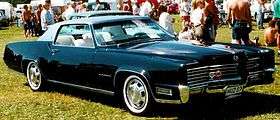 1967-70 Cadillac Eldorado
1967-70 Cadillac Eldorado 1968 Cadillac DeVille
1968 Cadillac DeVille 1972 Cadillac DeVille
1972 Cadillac DeVille 1976 Cadillac DeVille
1976 Cadillac DeVille
Downsizings & New Technology-Assisted Luxury Features: 1977–1988
In 1977, Cadillac's D-bodies experienced the same "downsizing" as the rest of GM's "B" and "C" bodied cars. DeVille models lost hundreds of pounds, received smaller exterior dimensions and engines, but gained taller windows. With these downsizings, fuel economy and handling improved. In 1979, Cadillac's flagship Eldorado coupe would downsize.
The 1980s saw a downsizing of many models including the DeVille, Fleetwood, Eldorado, and Seville. 1980 saw a dramatic redesign for the Seville featuring a bustle-back rear-end styling theme and a move to a front-wheel-drive chassis which it shared with the Eldorado. In 1982, the Cimarron was introduced as the brand's first compact car. 1985 saw the new front-wheel-drive DeVille and Fleetwood models released after quality delays prevented a planned 1984 model year introduction. 1986 saw new downsized Eldorado and Seville models. In 1987, the all-new Pininfarina-bodied Allante roadster came to market featuring the HT-4100 V8 engine. 1987 also brought the closure of Detroit Assembly on Clark Street in Detroit, where Cadillacs had been made since 1921.
The 1980s also saw the introduction of new, technology-assisted luxury features. Among these was the return of the memory seat option, not available since the 1958 Eldorado Brougham. 1981 brought standard digital heating and air conditioning controls to all models. In 1982, the High Technology engine was introduced. It was originally scheduled for a 1983 release, later delayed to 1985, with its intended applications being the downsized front-wheel drive models that Cadillac would introduce that year. 1983 saw the introduction of the Delco/Bose stereo system option, an USD$895 cassette stereo system available only on the Eldorado and Seville. This Bose system would eventually become available on the DeVille and Fleetwood models on their 1985 FWD editions. The Trip Computer, available for Eldorado in 1979 and Seville in 1978 and 1979, was replaced in 1981 with the availability of digital instrumentation with some Trip Computer functions being replaced by the new digital heating and air conditioning control panel. Digital instrumentation would become available for the new FWD DeVille and Fleetwood series in 1985.
 1978 Cadillac DeVille
1978 Cadillac DeVille.jpg) 1980 Cadillac Seville
1980 Cadillac Seville 1984 Cadillac Eldorado
1984 Cadillac Eldorado 1987 Cadillac DeVille
1987 Cadillac DeVille 1988 Cadillac Allante
1988 Cadillac Allante 1988 Cadillac Cimarron
1988 Cadillac Cimarron
New Introductions: 1989–1999
In 1991, Cadillac introduced the Northstar engine, which were a family of high-performance 90° V engines produced by General Motors from 1991 to 2010. Regarded as GM's most technically complex engine, the original double overhead cam, four valve per cylinder, aluminum block/aluminum head V8 design was developed by Oldsmobile's R&D, but is most associated with Cadillac's Northstar series. The related Northstar System was Cadillac's trademarked name for a package of performance features introduced in mid-1992 that coupled variable valve timing, road sensing suspension, variable power steering, and 4-wheel disc brakes to the Division's high-output and high-torque Northstar engines.
For 1992, the Seville was redesigned to better compete with luxury performance sedans from Europe and had adopted some styling cues from the 1988 Cadillac Voyage concept car.[36] A year later, the Brougham was discontinued and replaced by the all-new rear-wheel drive 1993 Fleetwood. The previous front-wheel drive Fleetwood was renamed Sixty Special for 1993. That same year, the Coupe deVille was discontinued due to the declining popularity of full-size coupes.
For 1994, the DeVille was redesigned to share the K-body platform with the Seville. The body was redesigned, although the wheelbase remained 113.8 inches—rather than the 111 inches used on the Seville. Production moved to Hamtramck, Michigan. Also for 1994, all DeVille models included a standard SRS driver-side front airbag, as well as fully digital instrumentation with integrated message center, which provided important vehicle information and status, current speed, outside temperature, and more, with controls mounted to the left of the instrument cluster. Also standard was a dual-zone front HVAC system, with controls located to the right of the instrument cluster, and remote controls on the front passenger door panel. A SRS passenger's-side front airbag became standard equipment after a restyling in 1996, which also brought revised exterior styling and new audio systems with TheftLock coded anti-theft technology. In 1995, the High Technology engine that had been used in Cadillacs since 1982 was discontinued.
For 1997, the Catera mid-size sedan was introduced as Cadillac's new entry level model. The DeVille was also redesigned that year. The late 1990s saw Cadillac field its first ever entry in the growing SUV segment. The Escalade, introduced in 1999, was marketed to compete with the Lincoln Navigator and luxury SUVs from various import brands.
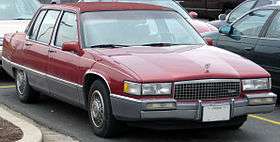 1989 Cadillac Fleetwood
1989 Cadillac Fleetwood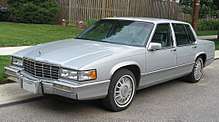 1991 Cadillac DeVille
1991 Cadillac DeVille 1992 Cadillac Seville
1992 Cadillac Seville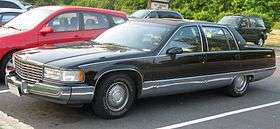 1993 Cadillac Fleetwood
1993 Cadillac Fleetwood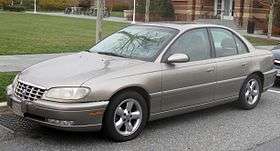 1997 Cadillac Catera
1997 Cadillac Catera 1997 Cadillac DeVille
1997 Cadillac DeVille
The Art and Science era: 2000–present
In 2000, Cadillac introduced a new design philosophy for the 21st century called "Art and Science",[37] which it states "incorporates sharp, sheer forms and crisp edges – a form vocabulary that expresses bold, high-technology design and invokes the technology used to design it." This new design language spread from the original CTS and to the Cadillac XLR roadster. Cadillac's model lineup mostly includes rear- and all-wheel-drive sedans, roadsters, crossovers and SUVs. The only exceptions were the front-wheel drive Cadillac BLS (which was not sold in North America)[38] and the Cadillac DTS, neither of which are still in production. In 2005, the Cadillac STS was introduced as the successor to the Cadillac Seville,.[39] which beginning in 1988 was available as an upscale performance-oriented STS (for Seville Touring Sedan) version, and comfort-oriented SLS (for Seville Luxury Sedan). The following year, STS received Cadillac's then-new Northstar System, including the aluminium DOHC L37 Northstar V8 engine.
The STS was Cadillac's highest-priced sedan, falling in size between the mid-size CTS and full-size DTS. In 2006, the DeVille nameplate was replaced by Cadillac DTS, an abbreviation dating back to 1986, when a "DeVille Touring Sedan" package was first available. The new name brought the DeVille into line with Cadillac's Art & Science-era nomenclature, which saw the Seville renamed to STS and the Catera replacement called the CTS. The last DeVille rolled off the Detroit/Hamtramck Assembly line on June 23, 2005.
The new second-generation CTS-V performance sedan was introduced in 2009 as a direct competitor to the BMW M5.[40] Powered by a supercharged OHV 6.2 L LSA V-8 engine, an automatic version of the CTS-V lapped the Nürburgring in 7:59.32, at the time a record for production sedans.[41] The last DTS rolled off the assembly line at 11:51 a.m. on May 27, 2011.[42]
In 2016, the Cadillac CT6 was introduced and was the brand's first full-size rear-wheel drive sedan since the discontinuation of the Fleetwood in 1996. In early 2017, Cadillac launched Book By Cadillac, a vehicle subscription service which was initially available in New York City. In November 2017, it was announced that Book by Cadillac would be expanding to Dallas and Los Angeles.
 2000 Cadillac DeVille
2000 Cadillac DeVille 2007 Cadillac DTS
2007 Cadillac DTS- 2008 Cadillac CTS
 2009 Cadillac CTS-V
2009 Cadillac CTS-V 2010 Cadillac SRX
2010 Cadillac SRX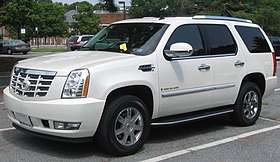 2010 Cadillac Escalade
2010 Cadillac Escalade- 2013 Cadillac ATS
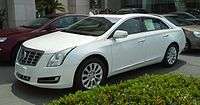 2013 Cadillac XTS
2013 Cadillac XTS 2014 Cadillac ELR
2014 Cadillac ELR
Models
Current
- 1999–present Escalade
- 1999–present Escalade
- 2003–present Escalade ESV
- 2003–present CTS
- 2003–present CTS Sedan
- 2004–present CTS-V Sedan
- 2013–present ATS
- 2013–present XTS
- 2016–present CT6
- 2017–present XT5
- 2019–present XT4
Future
- CT5
- XT6
.jpg) Cadillac ATS Coupe
Cadillac ATS Coupe Cadillac ATS Sedan
Cadillac ATS Sedan Cadillac ATS-L (China)
Cadillac ATS-L (China).jpg) Cadillac ATS-V
Cadillac ATS-V.jpg) Cadillac ATS-V.R
Cadillac ATS-V.R.jpg) Cadillac ATS-V
Cadillac ATS-V Cadillac CT6
Cadillac CT6_%E2%80%93_Frontansicht%2C_5._September_2015%2C_D%C3%BCsseldorf.jpg) Cadillac CTS
Cadillac CTS- Cadillac CTS-V
 Cadillac Escalade
Cadillac Escalade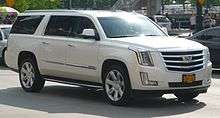 Cadillac Escalade ESV
Cadillac Escalade ESV_(cropped).jpg) Cadillac XT4
Cadillac XT4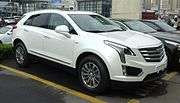 Cadillac XT5
Cadillac XT5 Cadillac XTS
Cadillac XTS
Assembly plants
- Lansing Grand River Assembly, Michigan, U.S.
- Detroit/Hamtramck Assembly, Michigan, U.S.
- Arlington Assembly, Texas, U.S.
- Fairfax Assembly, Kansas, U.S.
- Spring Hill Manufacturing, Tennessee, U.S.
- Oshawa Car Assembly, Oshawa, Canada
- Shanghai GM, China
Additionally, Russian company Avtotor assembles the Cadillac CTS and Cadillac Escalade under license in Kaliningrad.[43]
Advertisements
 A 1906 Cadillac advertisement, August 1906
A 1906 Cadillac advertisement, August 1906 A 1911 Cadillac advertisement: "Only the Good Endures" – Syracuse Post-Standard, 31 January 1911
A 1911 Cadillac advertisement: "Only the Good Endures" – Syracuse Post-Standard, 31 January 1911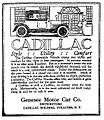 A 1917 Cadillac advertisement: "Style, Utility, Comfort" – Syracuse Herald, 30 September 1917
A 1917 Cadillac advertisement: "Style, Utility, Comfort" – Syracuse Herald, 30 September 1917 A 1919 Cadillac advertisement: Phaeton, 4-passenger touring – Syracuse Herald, 30 September 1917
A 1919 Cadillac advertisement: Phaeton, 4-passenger touring – Syracuse Herald, 30 September 1917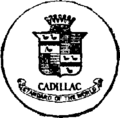 1921 logo
1921 logo Logo used 2003–14
Logo used 2003–14
Awards
Cadillac has won the Motor Trend Car of the Year award five times:[22] [44]
- 1949 Cadillac Motor Division - for innovations in overhead valve V8 engine design
- 1952 Cadillac Motor Division
- 1992 Cadillac Seville Touring Sedan
- 2008 Cadillac CTS
- 2014 Cadillac CTS
Motorsport

Before the outbreak of World War II, Cadillac (like most manufacturers) participated in various types of motorsport. Many Allard automobiles used Cadillac engines.
In the 1950s, Cadillac (like all American manufacturers at the time) participated in the NASCAR Grand National Series. The brand disappeared from the series by the 1960s.
Cadillac powered the Cadillac Northstar LMP a Le Mans Prototype in the early years of the American Le Mans Series from 2000 to 2002. When the prototype proved unsuccessful, Cadillac withdrew from the series. Cadillac's most successful venture into motorsport in recent years has been its use of the CTS-V in the SCCA World Challenge Grand Touring class.
See also
- Cadillac Northstar engine
- Cadillac V-Series
- Cadillac V8 engine
- LaSalle (automobile), companion make to Cadillac, 1927–1940
- List of Cadillac vehicles
References
- ↑ "Form 10-K Annual Report Pursuant to Section 13 or 15(d) of the Securities Exchange Act of 1934 for the Fiscal Year Ended December 31, 2012 Commission File Number 001-34960 General Motors Company" (PDF). General Motors. General Motors Company. 15 February 2013. Archived from the original on 6 August 2013. Retrieved 6 August 2013.
- ↑ Rick Kranz (30 November 2011). "Cadillac Develops New Strategy In Europe". Automotive News. Retrieved 27 December 2011.
- ↑ "Cadillac Global Sales Rise 15.5 Percent in 2017". Media.cadillac.com. 2018-01-05. Retrieved 2018-01-05.
- ↑ General Motors (1954). "Cars That Built GM: An Album of Historic General Motors Cars" (PDF). p. 8,12. Retrieved 12 October 2014.
- ↑ General Motors (1954). "Cars That Built GM: An Album of Historic General Motors Cars" (PDF). p. 10,12,14,16. Retrieved 12 June 2014.
- ↑ "Cadillac, Antoine de la Mothe, Sieur de". S9.com. 11 September 2007. Retrieved 14 June 2012.
- ↑ Granzo T History of Detroit
- ↑ "Cadillac: A Century of Excellence" by Rob Leicester Wagner ( ISBN 978-1-58663-168-0)
- ↑ Nazario (17 May 2012). "The Continual Innovation and History of Cadillac". GearHeads. Retrieved 14 June 2012.
- 1 2 3 4 5 6 Laam, Michael (January 2002). "100 Years of Cadillac History". Popular Mechanics. Archived from the original on 27 January 2010.
- ↑ "1909, Cadillac Enters the Fold". Generations of GM History. GM Heritage Center. Retrieved 26 July 2011.
- ↑ Bentley, John The Old Car Book, Fawcett Books (1952) p 12
- ↑ GM Heritage Center, http://history.gmheritagecenter.com/wiki/index.php/Canada_Only_General_Motors_Cars
- 1 2 "1930–1939 Cadillac". Retrieved 29 June 2011.
- ↑ "Earl, Harley J. GM's First Design Chief". Generations of GM History.
- ↑ Gordon, John Steele"The Man Who Saved The Cadillac". Forbes. 30 April 2009. Retrieved 23 October 2011.
- 1 2 Gordon.
- ↑ "The Beginning of the Phillips Screw Company". Phillips Screw Company. Archived from the original on 10 July 2011. Retrieved 3 June 2011.
- ↑ Bonsall, p. 17
- 1 2 "1957 & 58 Cadillac Eldorado Brougham". Generations of GM History. GM Heritage Center. Retrieved 26 July 2011.
- ↑ Flory, J. "Kelly", Jr. American Cars 1946-1959 (Jefferson, NC: McFarland & Coy, 2008), p. 190.
- 1 2 "Cadillac CTS Scores Second Motor Trend Car of the Year® Award". Media.cadillac.com. 2013-11-07. Retrieved 2016-07-16.
- 1 2 Flory, p. 255.
- ↑ Flory, p.323.
- ↑ 80 Years of Cadillac LaSalle by Walter M.P. McCall, Motorbooks International, Osceola WI, 1992, p. 298
- ↑ "Archived copy". Archived from the original on 26 February 2015. Retrieved 2015-01-25.
- ↑ 1956 GM Year-End Annual Report, 1957 Cadillac Eldorado Brougham car model introduction announcement, pg 15
- ↑ Radio & TV News, August 1957, "Delco's All-Transistor Auto Radio", pg 60
- ↑ The Cadillac Serviceman, Volume XXXI, No.4, April 1957 issue, Pg 34
- ↑ Flory, J. "Kelly", Jr. (2004), American Cars 1960–1972, Jefferson, NC: McFarland & Coy, pp. 423, 425–428
- ↑ Flory, p. 423
- ↑ Flory, p. 570. Karl Ludvigsen's "Cadillac: The Great American Dream Come True", in Northey, Tom, ed. World of Automobiles (London: Orbis, 1974), Vol. 3, p. 297, mistakenly dates this to 1967.
- ↑ Flory, p. 721.
- ↑ "Cadillac Eldorado History". Edmunds. 24 October 2011.
- ↑ Flory, pp. 20, 23, 878, & 880.
- ↑ "1988 Cadillac Voyage Concept". Supercars.net. Retrieved 2015-01-19.
- ↑ Robyn Meredith (12 November 1999). "THE MEDIA BUSINESS: ADVERTISING; Cadillac is redesigning its image before its retooled cars appear" (The New York Times). The New York Times. Retrieved 28 June 2010.
- ↑ "2006 Cadillac BLS -Car News". Car and Driver. Retrieved 9 June 2010.
- ↑ Newbury, Stephan (2006). The car design yearbook 4. Merrell. ISBN 1-85894-286-1.
- ↑ "2009 Cadillac CTS-V vs. 2008 BMW M5 SMG". Road & Track. Archived from the original on 9 August 2011.
- ↑ "Cadillac CTS-V Blisters the Ring in Under 8 Minutes". worldcarfans.com. Retrieved 28 June 2010.
- ↑ Ganz, Andrew (2011-05-27). "Last Cadillac DTS rolls off line… and into Bulgari Collection". Leftlanenews.com. Retrieved 2012-01-06.
- ↑ "Автотор - GM". Archived from the original on 24 July 2014.
- ↑ Lieberman, Jonny (January 2014). "Motor Trend Car of the Year 2014: The Strong Thrive: The 65th Anniversary of our Signature Award Finds the Automotive Industry Stronger Than Ever". Motor Trend. Source Interlink Media. 66 (1): 42–45. ISSN 0027-2094. OCLC 423854316. Archived from the original on 8 December 2013. Retrieved 2013-12-07.
Our mission was to determine exactly which of this year's 22 new or significantly refreshed contenders is in fact the best.
Further reading
- Bonsall, Thomas E. (2004). The Cadillac Story: The Postwar Years. Stanford University Press. ISBN 978-0-8047-4942-8.
External links
| Wikimedia Commons has media related to Cadillac. |
Cadillac vehicle timeline, 1930s–1970s — next » | ||||||||||||||||||||||||||||||||||||||||||||||||||
|---|---|---|---|---|---|---|---|---|---|---|---|---|---|---|---|---|---|---|---|---|---|---|---|---|---|---|---|---|---|---|---|---|---|---|---|---|---|---|---|---|---|---|---|---|---|---|---|---|---|---|
| Type | 1930s | 1940s | 1950s | 1960s | 1970s | |||||||||||||||||||||||||||||||||||||||||||||
| 0 | 1 | 2 | 3 | 4 | 5 | 6 | 7 | 8 | 9 | 0 | 1 | 2 | 3 | 4 | 5 | 6 | 7 | 8 | 9 | 0 | 1 | 2 | 3 | 4 | 5 | 6 | 7 | 8 | 9 | 0 | 1 | 2 | 3 | 4 | 5 | 6 | 7 | 8 | 9 | 0 | 1 | 2 | 3 | 4 | 5 | 6 | 7 | 8 | 9 | |
| Mid-size | WWII | Seville | ||||||||||||||||||||||||||||||||||||||||||||||||
| Entry-level | 60 | 61 | 61/63 | 61 | ||||||||||||||||||||||||||||||||||||||||||||||
| 65 | 62 | Series 62 | 62 | 62 | Calais | Calais | ||||||||||||||||||||||||||||||||||||||||||||
| Full-size | de Ville | de Ville | de Ville | de Ville | de Ville | |||||||||||||||||||||||||||||||||||||||||||||
| 353 | 355 | 70 | 60S | Series 60S | Series 60S | Series 60S | Series 60S | Series 60S | Fleetwood Brougham | |||||||||||||||||||||||||||||||||||||||||
| Limousine | 353 | 355 | 67/72/75 | Series 75 | 6700 | 6700 | Series 75 | Series 75 | FL Limo | |||||||||||||||||||||||||||||||||||||||||
| Halo | V-12 | |||||||||||||||||||||||||||||||||||||||||||||||||
| V-16 | 70 | Eldorado Brougham | ||||||||||||||||||||||||||||||||||||||||||||||||
| Personal Luxury | Eldorado | Eldorado | Eldorado | Eldorado | Eldorado | Eldorado | Eldorado | Eldorado | ||||||||||||||||||||||||||||||||||||||||||
« previous — Cadillac vehicle timeline, 1980s–present | ||||||||||||||||||||||||||||||||||||||||
|---|---|---|---|---|---|---|---|---|---|---|---|---|---|---|---|---|---|---|---|---|---|---|---|---|---|---|---|---|---|---|---|---|---|---|---|---|---|---|---|---|
| Type | 1980s | 1990s | 2000s | 2010s | ||||||||||||||||||||||||||||||||||||
| 0 | 1 | 2 | 3 | 4 | 5 | 6 | 7 | 8 | 9 | 0 | 1 | 2 | 3 | 4 | 5 | 6 | 7 | 8 | 9 | 0 | 1 | 2 | 3 | 4 | 5 | 6 | 7 | 8 | 9 | 0 | 1 | 2 | 3 | 4 | 5 | 6 | 7 | 8 | 9 | |
| Compact | Cimarron | BLS | ATS | |||||||||||||||||||||||||||||||||||||
| ATS-V | ||||||||||||||||||||||||||||||||||||||||
| ELR | ELR | |||||||||||||||||||||||||||||||||||||||
| Mid-size | Catera | CTS | CTS | CTS | ||||||||||||||||||||||||||||||||||||
| CTS-V | CTS-V | CTS-V | ||||||||||||||||||||||||||||||||||||||
| Seville | Seville | Seville | Seville | STS | ||||||||||||||||||||||||||||||||||||
| STS-V | ||||||||||||||||||||||||||||||||||||||||
| Full-size | de Ville | de Ville | de Ville | de Ville | DTS | XTS | ||||||||||||||||||||||||||||||||||
| Fleetwood (FWD) | ||||||||||||||||||||||||||||||||||||||||
| Sixty Special (FWD) | ||||||||||||||||||||||||||||||||||||||||
| Fleetwood Brougham | Brougham | Fleetwood (RWD) | CT6 | |||||||||||||||||||||||||||||||||||||
| Limousine | Fleetwood Limousine | Series 75 | ||||||||||||||||||||||||||||||||||||||
| Personal luxury | Eldorado | Eldorado | Eldorado | |||||||||||||||||||||||||||||||||||||
| Roadster | Allanté | XLR | ||||||||||||||||||||||||||||||||||||||
| XLR-V | ||||||||||||||||||||||||||||||||||||||||
| Compact crossover | XT4 | |||||||||||||||||||||||||||||||||||||||
| Mid-size crossover | SRX | SRX | XT5 | |||||||||||||||||||||||||||||||||||||
| Full-size SUV | Escalade | Escalade | Escalade | Escalade | ||||||||||||||||||||||||||||||||||||
| Extended length SUV | Escalade ESV | Escalade ESV | Escalade ESV | |||||||||||||||||||||||||||||||||||||
| SUT | Escalade EXT | Escalade EXT | ||||||||||||||||||||||||||||||||||||||